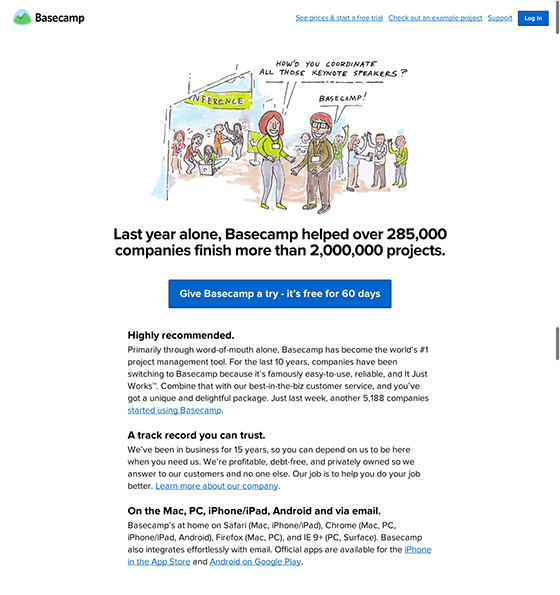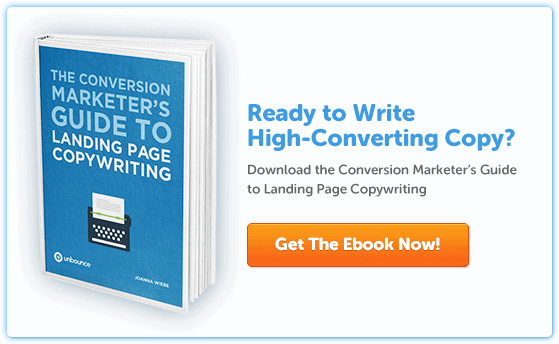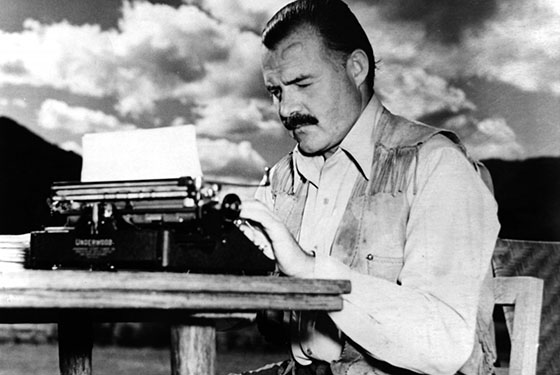
The “short pitch” is the purest form of marketing. When I started out in marketing in nineteen hrmpmubmmmumble, I did some copywriting for one-page print and direct mail pieces. They required really sharp, compelling, minimal prose. Ever try selling the virtues of a roof consulting firm in a four-inch print ad? Yeah.
Today, nothing demands more of a writer than creating copy for a landing page. You have to communicate your value, get the visitor to keep reading and get them to act. A tall order in any setting. And you have to do it all on a single page.
And while landing pages are online and print ads are, well, print, many of the same principles still apply. Here are eight copywriting tips that ring true regardless of where your copy appears.
1. Provide ROTI
Your first job when creating landing page copy is to provide Return on Time Invested, or ROTI. The first investment any potential customer makes is time. When they click that PPC ad and head to your landing page, they’re spending time – you need to make it worthwhile.
That’s the core principle of great landing page copy: As the customer, I have limited time. Tell me what I need to know. Tell me right away. Don’t get cute about it. Don’t make me hunt for it. I’m here because I have a need. Tell me how you’ll fill it or I’ll leave.
2. Sell the page
Don’t just sell the product. Sell the page.
The very first thing the reader sees should explain why they should stick around. Yes, a great headline helps. But follow up with more. Here’s what I mean:
- “Buy now!!!!” isn’t very effective on its own.
- “Need better widgets? Buy from us!” isn’t much better.
- “A lighter, stronger widget will improve your profit and decrease maintenance life cycles” is great, especially if you follow with “Here’s how.“
I’m not just pushing the product. I’m providing information. I’m going to tell you why my product is lighter and stronger. And, even if you don’t buy my product, you’ll come away with information.
3. Avoid plague words
Landing pages require compact prose.
Plague words are words that bloat prose – stuff like “at about” (which should be “at”) and “ask the question” (which can be shortened to “ask”). These words waste time. They lower ROTI. Or they confuse the reader, which in turn lowers ROTI.
Read this:
“Indeed, our cycling helmet is lighter and stronger due to our use of unobtanium.”
Now read this:
“We use unobtainium to make a lighter, stronger helmet.”
Same message. Fewer words.
Being concise is an art. You can find a tab-delimited list of plague words that I maintain here.
4. Show social proof
If you have lots of customers or you’ve handled 10,000 orders in 24 hours, make it known. Social proof is a powerful thing.
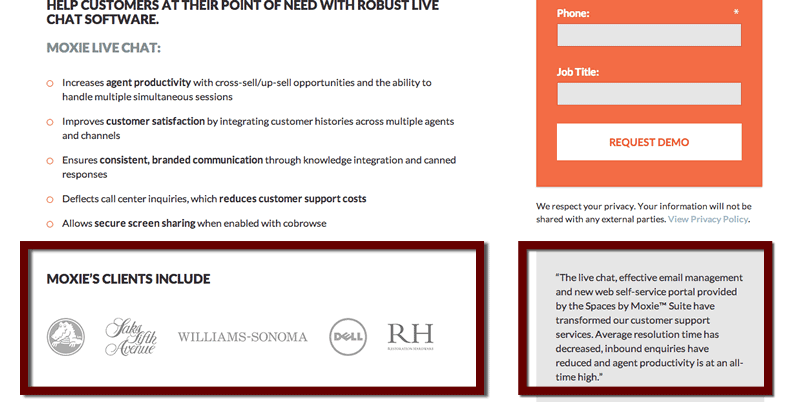
Social sharing buttons provide a great, basic example. When those little buttons that let you tweet, share and pin a particular piece of content show lots of other folks sharing, you’re more likely to share, too. We’ve tested this and found that as the share count increases, the rate of sharing accelerates.
Another test for a client really drove this point home. We set up an A/B test for e-mail subscription landing pages: Version 1 espouses the virtues of the information you’ll receive. Version 2 does the same thing, but adds a single line:
“4,500 current subscribers.”
The client, a publisher with 1 million+ website visitors per month was concerned that 4,500 subscribers was too low and might drive away potential subscribers. Subscription rates on version 2 went up 20%.
Social proof. Use it.
5. Try the Blank Sheet of Paper Test
If you wrote your headline, subhead, image caption or first paragraph on a blank sheet of paper and handed it to a stranger on the street, would they understand it?
That’s the Blank Sheet of Paper Test. The higher up on the page it appears, the more important it is that your writing be clear without context.
I’ve got some painful examples. Warning: these aren’t for the faint of heart:
“Supreme Court Tries Sodomy”
I’m an open-minded guy, but I don’t think that’s what they meant. This headline might be passable on a print page with explanatory text around it. Online, and especially without context, it’s a disaster. How about:
“Supreme Court Tries Sodomy Case”
A less painful example:
“Lighter. Stronger. The H1.”
Hmmm. What is the H1? If this is on a print page with a huge image, it could work. On the web, where I might see this in an e-mail, in a tweet or in some other snippet, it’s a mystery. Add one word and it starts to make sense:
“Lighter. Stronger. The H1 Helmet.”
If you have the room:
“Lighter. Stronger. The H1 Cycling Helmet.”
Here’s another doozy:
“Royals To Get a Taste of Angels’ Colon”
… I can’t fix that one, sorry.
6. Swing for the fences
On their site, Linode says their servers have “Zeus-like power.”
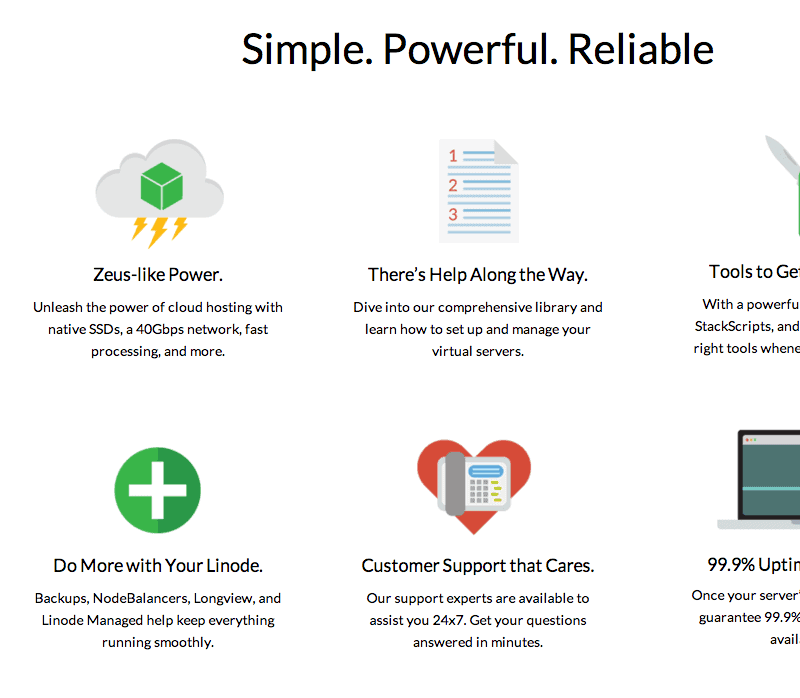
That’s pretty powerful.
David Ogilvy said that when it comes to copywriting, you must go big or go home. So go big. Don’t be cheesy, but make your claim in no uncertain terms.
7. Apply the breaks
If you have a long landing page, break it up with subheadings, images, bullet points and other goodies so that the reader can “rest” along the way.
Take a look at Basecamp’s homepage. It’s long, but the page is broken up with images and subheadings.
This page does a ton of other great things such as repeating the offer throughout.
8. Don’t use a checklist
I just gave you a bunch of “rules” for good landing page copy, but I’ve got one last bit of (counterintuitive) advice.
When you’re writing landing pages, the first rule is there are no rules. Try different things. Use a post like this as a starting point, but understand you’re writing for people and you’re writing about your own unique products.
Write smart, test everything and keep track of what works and what doesn’t. The knowledge you gain will get you out of checklist mode and into unique, effective copywriting mode.
Looking for more advanced copywriting wisdom? Register for our upcoming webinar by clicking the CTA below. If you can’t make it, we’ll send you the recording!
